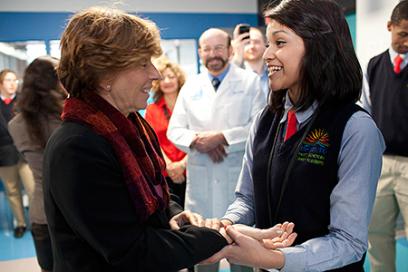Charter Schools as Incubators or Charter Schools Inc.?
When you hear the words “charter school,” what comes to mind? High expectations? High student attrition? High achievement? Lack of transparency?
There’s no right or wrong answer, because charter schools, like other public and private schools, vary widely. The top-ranked high school in Louisiana is a unionized charter school. On the flip side, a recent study of students enrolled in online charter schools found that they lost 180 days of learning in math over the 180-day school year. (You read that right.)
Charter schools are publicly funded schools with flexibility in program design and operations. The late AFT President Albert Shanker was one of the first proponents, believing public school teachers could incubate innovative ideas, sharing successes and learning from setbacks. That was our goal in creating University Prep, a charter school in the South Bronx that the United Federation of Teachers co-founded with Green Dot Public Schools when I was UFT president. Now in our eighth year, 98 percent of students graduate, and almost all go on to college. The goal was never to undermine the many extraordinary district public schools—or to close or make it harder for traditional public schools.
Unfortunately, some charter proponents have shifted the intent of charters from incubating ideas and sharing successes to competing for market share and taxpayer dollars. A pro-charter group in New York recently ran deplorable ads suggesting they care more about equity than Mayor de Blasio does. The reality is that some charter school operators want to take public funds yet behave like private entities that can play by different rules.
Charter schools tend to enroll fewer students with disabilities, fewer English language learners, and a less-poor population of students than do nearby public schools. Reuters has reported on practices some charter operators use to “get the students they want.” Some require character references from a religious or community leader, entry exams, or completion of lengthy forms (often only in English). A Philadelphia charter school accepted applications only one day each year—at a suburban country club.
Some charter schools reportedly “counsel out” or expel students just before state testing day. Recent exposés revealed that the Success Academy Charter Schools chain has suspended or expelled children as young as kindergartners—often for minor infractions—at a rate seven times higher than elementary students in New York City’s public schools.
A new report revealed more than $200 million in fraud, waste and mismanagement in the 15 states examined of the 43 states that allow charters. The U.S. Department of Education this fall awarded $71 million for charter schools to Ohio—whose charter schools are notorious for financial and ethical scandals and academic results that lag far behind traditional public schools—prompting an outcry from the state auditor. Federal officials have since placed restrictions on the funds.
Since 1995, the Education Department has awarded more than $3 billion to create and expand charter schools throughout the country, despite warnings by its inspector general that the department has provided inadequate oversight of federal funds sent to charter schools.
These failings hurt the charter school operators who are trying to operate aboveboard with students’ best interests in mind. And rampant charter expansion undermines traditional public schools. A proposal to “charterize” half of the public schools in Los Angeles would not just disrupt the public school system, it would destroy it. Neighborhood public schools would be stripped of essential resources, programs and personnel, and the district would be bankrupted. These schemes, also playing out in Boston, Chicago, Philadelphia and elsewhere, aim not to supplement public schools but to supplant them. There must be robust debates about proposals that so radically privatize public education.
“Charter” does not mean “better.” A well-regarded Stanford University study found that 25 percent of charter schools perform significantly better than traditional public schools, while 31 percent produce academic results that are significantly worse.
Hillary Clinton, a longtime supporter of charter schools, was recently lambasted when she called for accountability for all public schools. She noted that some charter schools “don’t take the hardest-to-teach kids, or, if they do, they don’t keep them. And so the public schools are often in a no-win situation, because they do, thankfully, take everybody, and then they don’t get the resources or the help and support that they need to be able to take care of every child’s education.” She’s right.
The public education landscape is enriched by having many options—neighborhood public schools, magnet schools, community schools, schools that focus on career and technical education, and charter schools. They all must be held to educational, financial and ethical standards, particularly now, given that half the children in public schools are poor. This is a solemn responsibility to both students and the public.

